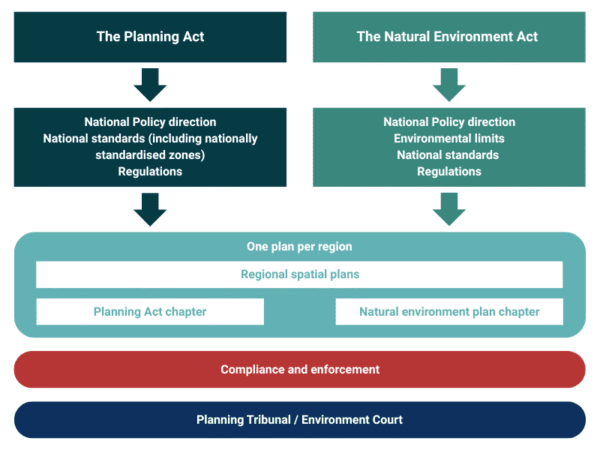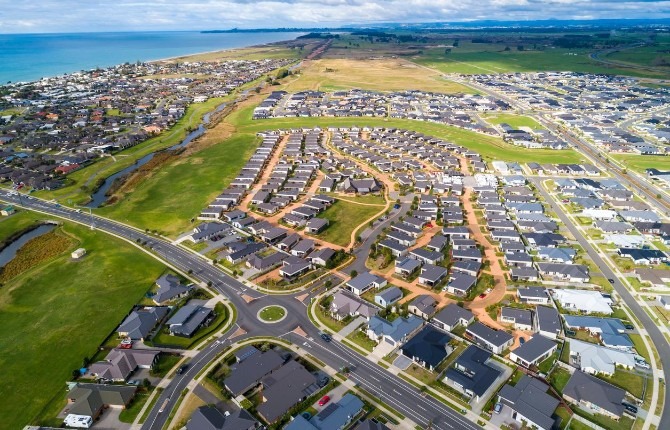The Government is pressing ahead with the most significant overhaul of New Zealand’s resource management system in a generation. With two new Acts set to replace the Resource Management Act (RMA), the reforms will be wide-reaching and complex.
Taituarā, together with local government leaders and practitioners, and the Ministry for the Environment (MfE), is working hard behind the scenes to ensure councils have the clarity, support, and information they need to respond with confidence.
We know this level of change will create stress and uncertainty in the sector. To help ensure we are all on the same page and as informed as possible, we will be sharing regular updates to the sector, starting with this one. This update takes you through the proposed changes along with the work we are doing currently, and have planned, to respond to these changes.
Change overview
At a high level, the Government is replacing the RMA with:
- a Natural Environment Act to establish a framework for the use, protection and enhancement of the natural environment
- a Planning Act to establish a framework for planning and regulating the use, development and enjoyment of land
The key components include:

The Expert Advisory Group (EAG) report published in March 2025 provides the best foundation to understand what the Government proposes regarding the replacement of the RMA. This report continues to be referred to as “the blueprint”. And here are cabinet decisions that help us understand how the EAG’s report is being refined and developed into two Bills that will replace the RMA.
Features of the proposed system agreed to by cabinet include:
- Two new Acts: one to enable urban development and infrastructure / other to manage environmental effects
- Simplified national direction and cohesive national policy direction under each Act
- A single combined plan per region with spatial, natural environment plans and land use plan chapters
- A prescribed framework for environmental limits
- Standardised planning provisions and performance standards, including nationally standardised zones
- Fewer activity categories and a higher threshold for determining affected persons
- Higher threshold for adverse effects managed through consenting/permits
- Shift away from consenting towards monitoring and enforcing national standards and consented activity
- A Planning Tribunal for minor dispute resolution
- Treaty of Waitangi settlements and Crown’s obligations upheld
Timeline
Once introduced to Parliament, each Bill will undergo a First Reading. If it passes, it progresses to the Select Committee stage, where it is subject to detailed scrutiny and public consultation. These Bills – presently named the Natural Environment Bill and the Planning Bill – are intended to pass into law in 2026, subject to the parliamentary process. Councils will begin work on their first spatial plan chapters under the new system following enactment, followed closely by work on regional combined plans
Based on this, the sector should anticipate resource being needed for preparation of spatial plans soon after enactment and the development of combined plans to follow.
We will update the sector as soon as further information is available.
Challenges
There will be many challenges over the coming months. For now, we’ll focus on the immediate challenges:
- Timing of the Bills:
- The introduction of the Bills (late November, TBC) coincides with new councils being formed following elections – this will impact on making submissions and the visibility of proposals, particularly for newly elected members
- The submission period will fall over Christmas and the summer break
- Councils are working on their Long-Term Plans (LTP) with budgets being reviewed now by staff and confirmed internally in Nov/Dec. There is insufficient detail on this reform and the implementation timeline to build into planning.
- A lack of information at this stage:
- About what costs might fall to local government and what might be picked up by central government.
- The volume of change – this not the only major change the sector is managing – how will RM reform align with:
- Systems Improvements Bill
- Local Water Done Well
- Local government reform (signalled by the Government)
How are we working with the sector?
Local Government Practitioners Group (LGPG)
The LGPG was set up in 2023 by MfE, Taituarā and Te Uru Kahika. It comprises local government practitioners from territorial authorities and regional councils, members of the Taituarā resourse management reference group (RMRG), Taituarā and Te Uru Kahika. It has provided advice on policy proposals to amend RMA national direction. LGPG’s focus is now on implementation, how proposals will land on the ground and be implemented.
System Thinkers Group (STG)
The STG operates at a strategic level, focused on transition and implementation. Members of the group include LG Chief Executives, members of RMRG, Taituarā, Te Uru Kahika, New Zealand Planning Institute (NZPI) and the Association for Resource Management Practitioners (RMLA).
The Systems Thinkers group has identified a number of critical areas for collaboration to support effective implementation including: digital enablement, the “critical path” for the transition, workforce and resourcing, Māori partnerships and Treaty Settlements.
The focus is making sure the right people are involved, the right questions are being asked, and working to make sure the sector will have the information it needs at the right time including working to make sure the sector will have the information it needs at the right time including for financial planning and resourcing.
Secondments
A number of secondments into MfE will become available to ensure the LG context is accurately represented and policies are designed for implementation.
Current opportunities exist for planning professionals to be involved the development of standardised zone provisions and overlays that will be a feature of the new system. If you are interested, please contact Clare Wooding at clare.wooding@taituara.org.nz
What’s next?
Taituarā is planning a webinar on 9 December. This is timed to come directly following the release of the Bills with the purpose of assisting the sector to prepare submissions. Register here.
This is a major priority of the work going on at Taituarā and work is underway to make sure we are well placed to support you and your teams to implement and transition to the new RM system, including building capacity/capability. We are also working on what events we can offer to support implementation.
We will continue to provide further updates when information is available. MfE’s website is also a good resource: Changes to resource management | Ministry for the Environment you can sign up to receive their updates here.




